John Carter: Pioneer Of New Worlds
“I know a man in Christ, fourteen years ago, (whether in the body I know not, or out of the body I know not, God knows) such a one caught up to the third heaven…”
— the apostle Paul in his second letter to the Corinthians (2 Cor. 12:2)
This Friday, March 9th, the world will be asked to celebrate the centenary year marking the release of the novel that gave birth to Mos Eisley, Space Pirates, Airships, and Princesses who take care of themselves, when John Carter sets foot in theaters — perhaps a more frightening venture than his fateful trip to the red planet.
Like any good fan of literature, I wanted to be fully prepared to take in the sights of Mars and its hero and picked up a copy of the book this last month: A Princess of Mars, first in the series by Edgar Rice Burroughs. I had been wanting to read it for a while now anyway, having just finished C.S. Lewis’ marvelously deep and weird Space Trilogy (another child of Burroughs’s John Carter series) just after Christmas. I really didn’t know what to expect from the guy who most famously wrote about a guy in a loincloth who grew up with monkeys, but from the many cheers my male colleagues have given this book series over the years, I expected something fun. What I got was so much more than that.
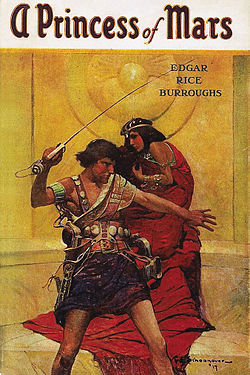
“A Princess of Mars” (in book form) was published in 1917.
The most important thing to understand before attempting Edgar Rice Burroughs’s iconic classic is — in case you hadn’t already guessed from the term “centenary” — that the first version of his story, serialized a year later in The All-Story magazine, was written in 1911.
Let me say that again in case you didn’t understand. It was written in 1911. If that year means nothing to you, let’s put that in perspective. In July 1911, Hiram Bingham rediscovered Machu Picchu. The Titanic did not set sail until a full year later. World War I had not yet begun — which meant Russia still had a czar. Oh, and the Panama Canal had not yet been built.
So what, you say? To put this in a literary perspective, Sherlock Holmes stories were still being printed in The Strand. From a scientific perspective, John Carter went to Mars before the invention of stainless steel or Einstein platformed his theory of general relativity.
Sinking in yet? Feature films did not yet exist. Jazz had never been recorded. We still bought our newspapers from little kids in knickers shouting Extra! Extra! and women (who couldn’t even vote) were still in corsets.
So, all with that in mind, imagine my consternation at finding the following featured comment about Disney’s John Carter previews this last week:
“Looks like every other Star Wars wannabe fantasy action movie out there… from the trailer looks like it suffers from an anorexic plot and brings nothing new to the table.”

Han shot first. And “John Carter” told this story first.
Nothing new to the table? Forgive me for copping a bit of a Han Solo attitude here but, in the universe of science fiction, John Carter is the table, sweetheart.
Then again, Disney has not been all that clear in conveying to the masses that nearly every space pirate, dusty alien cantina, awesome landspeeder, saddled desert lizard, and feisty princess that we adore was born out of this book written 100 years ago.
So how did it start? In a time when literature began to be bogged down by depressing psychological muckety-muck, what spark lit Burroughs’s own extraordinary imagination when he first put pen to paper?
Red Planet rising
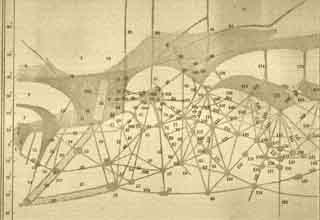
Lowell believed he saw, on Mars, canals — later also an element in Burroughs’s novels.
In the early part of the last century, in Flagstaff, Arizona, a man named Percival Lowell was busy staring at the same stars in his observatory atop the now famous mountain, Mars Hill. This namesake was adopted when in 1906, Lowell published his stunning observation of what appeared to be canals on Mars. Soon, the corseted and knickered world was ablaze with the notion that a sister planet showed possible signs of life. Just five years later, inspired by the good news from Mars Hill that we might not be alone, John Carter was born.
His tale opens with a prologue. Without giving anything away, I will say that it is quite possibly one of the greatest hooks I have ever read. My immediate response was to devour the rest of the book as quickly as possible to find the answers to the extraordinary circumstances relayed in those first few pages.
Chapter One did not fail to draw me in further as we find in the first few sentences that John Carter is thirty. Did I mention that he has been thirty for a very long, long time? (Twilight haters can cringe here.) His story is told through his own journals, detailing adventures that began in the decade following the Civil War. As would be expected from a man of that era — Carter is chivalrous, noble, and war-scarred. Searching for gold and a new life in the dusty hills of Arizona, he strikes upon a strange cave one day as bloodthirsty Apaches are hot at his heels. Only this was no ordinary cave. It was — eeep! — a portal to another world.
World of a savior
Now I won’t tell you how John Carter actually got to Mars by entering that cave (and, incidentally, neither does he), but I can tell you that little boys everywhere (including this guy named Carl Sagan), after reading about it, went outside and tried it themselves. When it didn’t work they didn’t stop trying. They grew up and started the space program.
 When our hero arrives in this strange new world, he finds it fully occupied. Of course. Indeed, it is a veritable hive of scum and villainy. Among the colorful aliens of Mars are titles like jeddaks and padwars (jedi and padawans anyone?), and creatures like Tharks and thoats. It becomes obvious very quickly that Burroughs set the standard for naming science fiction characters for generations to come as few, if any, have recreated anything since that don’t ring familiar of these original adventures. This incredible, fully realized cast and the detailed landscapes were unlike any the world had ever seen before — but would certainly see again and again.
When our hero arrives in this strange new world, he finds it fully occupied. Of course. Indeed, it is a veritable hive of scum and villainy. Among the colorful aliens of Mars are titles like jeddaks and padwars (jedi and padawans anyone?), and creatures like Tharks and thoats. It becomes obvious very quickly that Burroughs set the standard for naming science fiction characters for generations to come as few, if any, have recreated anything since that don’t ring familiar of these original adventures. This incredible, fully realized cast and the detailed landscapes were unlike any the world had ever seen before — but would certainly see again and again.
We quickly find that the most important character in this parade is the Princess of Mars, Dejah Thoris. If ever there existed a template for the feisty Princess Leia, the strong-willed Princess of Helium fits the bill. That’s right. I said Helium. It’s okay, you can giggle. I know I did. Every time she had a line, I expected her to sound like a Chipmunk. Of course, at the time she was named I’m pretty sure the world had not yet discovered the amusing byproduct of sucking a little helium out of a balloon. That aside, Dejah Thoris is a pretty rock-solid female character who holds her own head high in a testosterone driven story and sets a terrific standard of courage — something the rest of the literary world still struggles to get right in my humble opinion.
But wait! There’s more! Thanks to the difference in gravitational pull and atmospheric pressure John Carter has superhero-like powers on Mars! He is quite literally “able to leap tall buildings in a single bound.” In fact, it is this ability to leap that makes John Carter instantly famous on the red planet.
The societies there are what we would expect them to be on a planet named after the mythological Ares. They’re at war. Some have completely forgotten how to laugh at anything but pain. Many have forgotten how to love.
Into this broken place, John Carter comes. A hero from another world, with powers unlike any they’ve ever seen. A hero whose morals — especially his kindness — are a breath of fresh air to many and the scent of death to others.
Before the novel is over, Burroughs writes — unintentionally I am certain — a nearly perfect type of Christ. His warrior messiah literally becomes the shield of Mars and the lifter of their heads. Still, it is obvious that Burroughs’s intended take on his hero of Mars is a purely humanistic one. Man’s goodness is frequently praised, if only by consistently comparing John Carter with the “devolved” Tharks and the Zondangans. Humanity is only advanced because they have allowed themselves to evolve through the arts and sciences. But to those readers who recognize that there is nothing new under the sun, the imagery of a savior is fairly clear, and many Christian authors who enjoyed the adventures of John Carter would be inspired to later perfect it.
World of the story
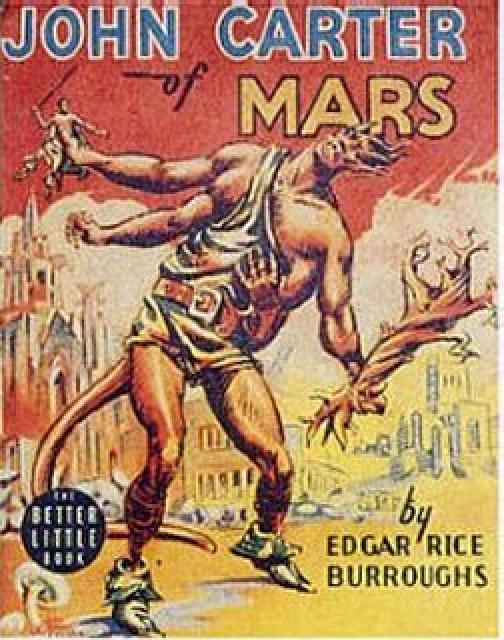 While the imagery is highly imaginative, at first glance, Burroughs’s writing feels a bit forced. His pen stumbles through a stilted prose that modern literary critics would hammer to pieces if this manuscript hit the presses for the first time today. But remember, Burroughs isn’t trying to sound like someone else or write as a genre expects — he is blazing into new territory. He is turning the wheel of invention.
While the imagery is highly imaginative, at first glance, Burroughs’s writing feels a bit forced. His pen stumbles through a stilted prose that modern literary critics would hammer to pieces if this manuscript hit the presses for the first time today. But remember, Burroughs isn’t trying to sound like someone else or write as a genre expects — he is blazing into new territory. He is turning the wheel of invention.
There is a voice here similar in its accessibility to the transcendent style of H.G. Wells, but Burroughs stretches himself further. In places, you could really picture Conan the Barbarian grunting out the spare dialogue — in others, Rudolph Valentino. But it works. Mars is sparse and John Carter’s voice has become as sparing in poetry as the planet that has changed him. While this developing style wears one’s patience from time to time, one feels that the story would not have worked any other way. A story whose type was completely alien to readers in its day needed to be told in a style just as alien. A reader would have needed some subconscious evidence that John Carter had truly traveled away from their high-collared society — that he had gone into the wardrobe a child and come out a king. Burroughs’s (then) new style delivers this necessity.
Let’s be frank. The act of giving birth is messy. It’s even a little shocking. John Carter was certainly that kind of story in 1911 — imperfect and untamed. In opening its pages, men became witness to a new genre being born.
For those of us only reading now, we may enjoy the inheritance of a radical new knowledge — the knowledge that a lot of those guys we look up to, whether writers or filmmakers or even rocket scientists — the ones that feel so far above us in our own aspirations — began just like us, as just a bunch of kids reading a great story.
Science fiction’s greatest power has never strayed far from this original Burroughs plot. When John Carter stood on Mars for the first time, he did more than have a great adventure. He overthrew the notion that man is the center of the universe. He challenged us to stand on a distant planet and look back on our own world from the perspective of an alien. In doing that, we may understand more fully who we really are.
While the story of John Carter may not be the best of all science fiction tales, it represents the beginning of a new era of thought — one in which the human creature is but a subplot in a greater story. The thrill of believing that this life was not all that there was — that this planet was only teetering on the edge of a Space Deeper than the human mind could even imagine — was a catalyst for great scientific and spiritual discovery for decades to come.
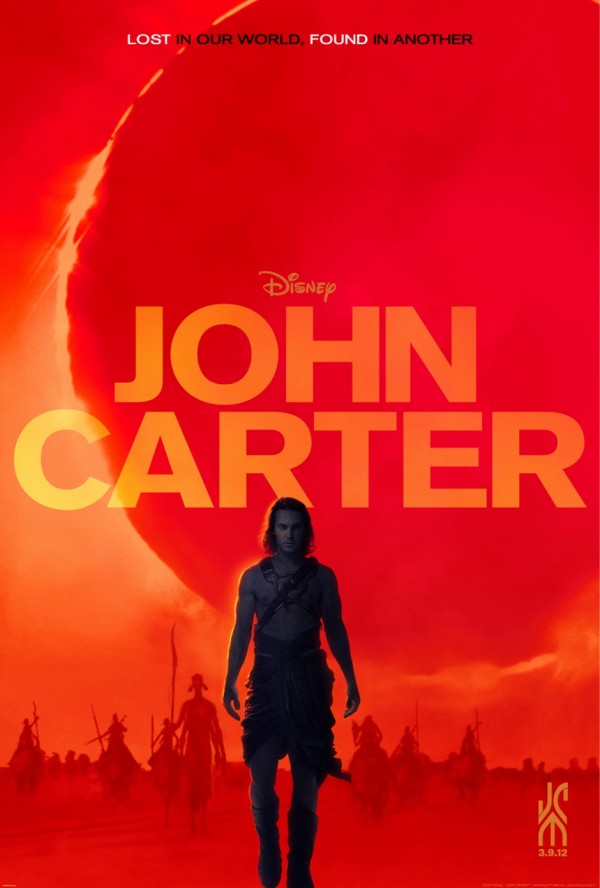 And they are still coming. While John Carter didn’t present the most accurate picture of the universe, or perhaps even ask all the right questions, the series launched a flood of human imagination that — within a few mere decades — took man to the moon. Granted, man is still debating about Who fills our Universe, but we all share an equal sense of wonder at the mindboggling vastness of His creation. And as the apostle Paul declared from atop Mars Hill two thousand years ago (Acts 17: 22-34), that is the beginning of True Discovery.
And they are still coming. While John Carter didn’t present the most accurate picture of the universe, or perhaps even ask all the right questions, the series launched a flood of human imagination that — within a few mere decades — took man to the moon. Granted, man is still debating about Who fills our Universe, but we all share an equal sense of wonder at the mindboggling vastness of His creation. And as the apostle Paul declared from atop Mars Hill two thousand years ago (Acts 17: 22-34), that is the beginning of True Discovery.
In freeing Mars, John Carter set free a new creature in the garden of artistic thought. Humility. What is more humbling than a thousand billion stars that we know nothing about? When man is small and he knows it — when he turns his eyes on the universe and finds that from its top to its bottom and all in-between, a consistent and Divine Nature beyond his ability to ever grasp — well, that is the making of a Great Story. A better story than Burroughs could ever tell.
Even so, I will definitely be popping my copy of Gustav Holt’s The Planets in the CD player this weekend, and driving my dad to the theater to share a bucket of popcorn with me as we say thanks to John Carter for the Millennium Falcon, Dr. Elwin Ransom, Narnia, and boldly going where no man had gone before.

































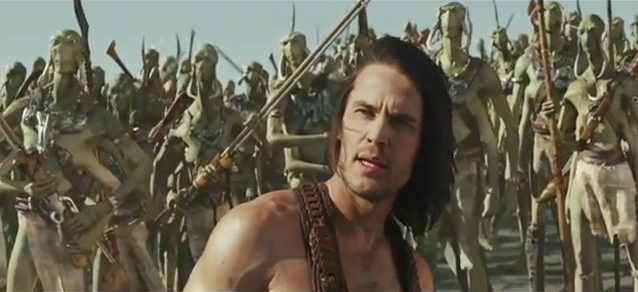



Melissa, that is an excellent review and commentary on the book, and how it fits into the timeline of not only world history but also the development of a genre.
In fact, this is one of the most entertaining and well-written blog posts I’ve read in a while.
Thank you very much! I’m glad you enjoyed it.
Great review, Melissa. I have to laugh at those who mark something as bad and the same old, same old, when it in fact preceded the “same old, same old”. I am going to start on this in the next few days, as you’ve piqued my interest. 🙂 And the trailer is interesting too. 😀
That is a truly great review, since it makes me excited not only about the book and the new movie, but excited in general about the wonder that those media convey.
Here’s some more good news: A Princess of Mars is available for free download (legally, as public domain) from Project Gutenburgh!
I had to stop reading, because I haven’t seen the movie/read the book, but I have to say that
is an awesome line.
Thanks, Kaci! Just so you know, I went to extra lengths to avoid spoilers. You shouldn’t see much more story information in this article than you would on the inside of a book flap.
Oh, okay. Sweet. 0=)
From Bainespal:
I’ve also just found the public-domain version of A Princess of Mars in Kindle version, for free. Also, for commuters, joggers, and those doing dishes, who want to work and read at the same time, Librivox — which provides free audiobooks narrated by volunteers — offers this book as well, accessible here.
The Barsoom Tales were far ahead of their time. Swashbuckling, over-the-top sci-fi that would inspire all who came later. Hopefully the movie will introduce them to a new generation. I also hope the movie adaptation will succeed enough to produce the sequels. If you haven’t read these books, order them now! Hollywood doesn’t go to Mars very often. Maybe this will give new life to the dead red planet.
I’m generally not an e-book fan, but that sounds like something I might just want to read. I’m not turned off by older sci-fi: In fact, I much prefered reading Perelandra (or was it Out of the Silent Planet?) to the Air and Space Museum in Washington, D.C.